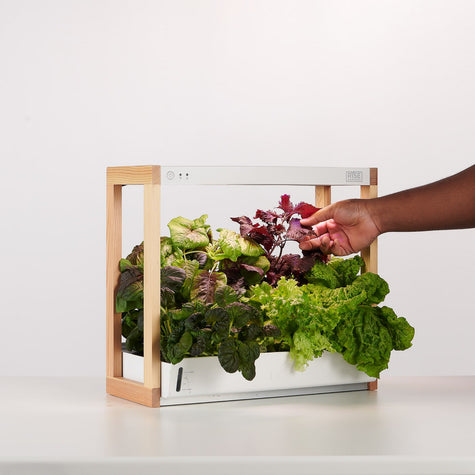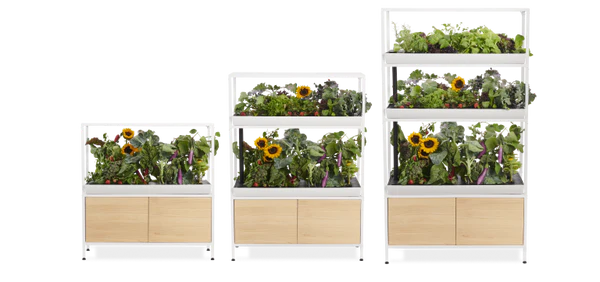So, you want to garden year-round but you aren’t sure where to start. We’ve got your back. Here’s a no BS guide to everything you need to know about purchasing an indoor hydroponic garden.
First, let’s start off with what exactly hydroponic gardening is. To put it simply, it’s a gardening method that skips soil altogether and allows you to grow plants in water.
While gardening outdoors and hydroponic gardening is very similar, there are a few key differences you should understand before you get started.
Gardening outdoors exposes plants to many of the necessary elements essential for growth.
First, you need space, which could be a raised garden bed, containers, or a portion of your yard. You have soil to provide a steady place to grow and source nutrients from, sun to turn those nutrients into energy to encourage growth, water to hydrate them (most of the time), a slight breeze to help make your plants strong and lettuce extra crunchy, and bees to pollinate your plants’ flowers and initiate a bounty of veggies throughout the warmer months of the year.
When you garden indoors, you have to recreate these elements for your plants to grow, thrive, and produce harvests. Instead of soil, hydroponic gardening uses water and non-soil plant pods that provide a medium for your plants to grow and access plant food. Instead of sun, you need to find the right light sources that activate the vitamins in the plant food to promote growth. You get the idea.
In this guide, we’ll walk you through what you should consider when purchasing an indoor hydroponic garden. Since our team has tried almost every hydroponic garden on the market, we outline everything you need to know including design, lights, technology and more.
Design
Choose a garden that fits best in your home
Aesthetic
Because this garden will live inside your home year-round, it’s important to pay attention to the design of the product and how it will fit into your home. You spend a lot of time in your home and making the space yours. When you bring new items in your home, you want it to integrate easily into your home and life. Consider your interior design, where the garden will be placed in your home, and how it works with your day-to-day life. The more the garden design seamlessly fits into your home, the more options you have around the home to place your garden. If it’s not as aesthetically pleasing, it’s likely not something you would want your guests to see when they walk through the door. Of course, just like the bottom drawer of the refrigerator, if you put the garden in a place you don’t go to much, you might forget about it.
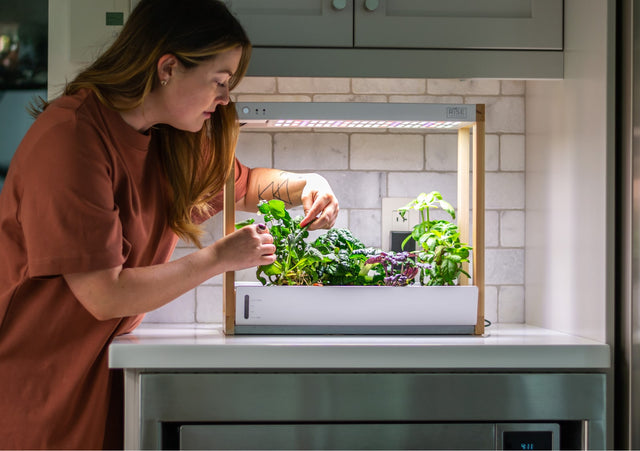
Materials
Higher-quality gardens will avoid PVC pipes and plastic for the main structure as well. Metal, wood, and ceramic materials are the best for the main structure to ensure a maximum lifetime for your garden. Plastics will show wear and tear sooner than other materials too. You’ll want to select a garden with replaceable plumbing since hydroponic gardens have nutrient dense water that can collect minerals over time.
Cleaning
While indoor hydroponic gardening makes it simple to grow and is generally fairly easy, gardening is gardening and does require a little bit of work. Cleaning your garden is essential to the longevity of the system itself and to the health of your plants.
From a functional design perspective, your garden should be easy to clean with a fast disassembly and dishwasher-safe parts. The main water reservoir should be easy to lift, fast to refill, and quick to clean. Gardens can accumulate micronutrients over time and will need a full water reservoir change once every 6 months, depending on how heavy your usage is. It’s best to avoid gardens with integrated plumbing within the structure as these are the hardest to clean and make it harder to replace individual parts vs having to buy a completely
Size
Find the garden that fits your space, lifestyle and gardening goals
Garden Footprint
When growing vegetables indoors, you need to consider where you are going to garden. Take a look at your home and determine where you have the space (and remember, light does not matter as hydroponic gardens use LED lighting for growth). Gardens range in height and footprint so you’ll need to take that into consideration when choosing a system. Some gardens, like countertop gardens, can easily fit into your space. Many larger gardens will need to have space created for them.
If you’re in a small New York City apartment, it might be challenging to find space for a larger system. In that case, you should look for gardens that have dual purposes or can double as furniture. A garden that offers modularity allows you to scale your system up or down depending on the space you have. If you move homes or need more growing capacity, you can add or remove levels to fit your needs.
Number of Plants
Speaking of capacity, another important factor to consider when selecting a garden is how much produce you would ideally want to grow. Here are some questions to ask yourself when determining what plant capacity you need:
- How many people are in your household?
- What are your gardening goals? (Eating veggies at every meal, a salad every day, replacing a % of your grocery bill)
- What do you like to cook or make? (Pizza, salads, buddha bowls, cocktails)
- Do you have any lifestyle considerations like a majority plant-based or vegan/vegetarian diet?
The more vegetables you need, the larger unit you will need. If you only want fresh herbs for dinners, smoothies and cocktails, a countertop garden will likely be your best fit.
You’ll also want to consider whether your garden has the capacity to crop plan. Crop planning in your garden is more than thinking about what plants you want to grow. Crop planning allows you to plant a variety of crops (plants) in sequential order. Meaning, if you want a salad every day and your garden only has capacity for 36 plants, you won’t have much space for anything other than lettuce greens or you will end up with gaps between harvests.
Plant Height
The size of the garden also determines what types of plants you can grow. Most gardens can support the growth of leafy greens and herbs, but if you plan on growing larger plants like peppers, tomatoes and eggplant, you’ll need to make sure that your garden has more than 12” from the base of the plant to the lights. Some gardens allow you to grow fruiting vegetables, microgreens, rooted plants and vining plants–while others are not able to support those. If you want to grow these plants, you’ll need to look for gardens that provide the support and space your plants need.
Smart Tech
Look for the functionality that makes growing easy
Smart Control
Unlike outdoor gardening where the amount of light, the amount of rain, temperature, and humidity are all variable, indoor gardening has a lot more certainty. That certainty comes from sensors like a thermostat, and most likely, sensors in the hydroponic garden that are constantly getting data to improve plant growth. Most modern indoor gardens will be connected to the internet to allow for the basic function of sending you a notification that your garden is low on water. More advanced gardens will give you full control of the lights, and allow you to input water quality data to adjust your nutrient levels. Adjusting your nutrients is the number one way to grow a better garden.
Indoor garden companies may want to make it seem simple to use their product, but plant-nutrient management is incredibly complex and requires a lot of fine tuning. A smart system connected to your phone should help you grow better as each company will have a different nutrient solution.
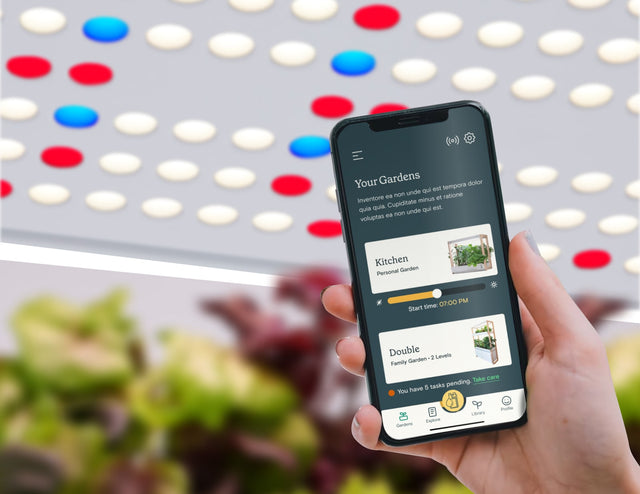
Tap Water Management
Even though it may seem straightforward that your plants just need water, light and nutrients, the water aspect can get complicated when you start thinking about tap water. All tap water is different because of how it’s regulated and treated by your specific municipality, and how your local system (home plumbing) handles that water, point-source. Making sure you have compensated for the extra (or lack of) minerals in your water can have a huge impact on the health of your plants due to pH management. This complicated balancing act will be handled in your mobile app by more high-end and sophisticated systems, and never discussed by the others since they can’t solve for it.
Plant Management
The other major app feature that should be present is plant management. With nutrient adjustments come necessary plant growth tracking technology. This does not have to be anything too special, but should allow you to track the growth of your plants and manage when you have put them in, as well as when you have harvested them.
If you are a newbie gardener (or are missing that green thumb you’ve always wanted) and need more guidance when it comes to thinning or pruning plants, look for gardening companies with mobile apps that go beyond the basics. Many tech-savvy companies have developed apps that will trigger in-app notifications to care for your plants at different stages of growth. These apps make it harder to fail, and increase your success rates and yields!
Seeds
Find good seed availability, variety and quality
Seed Selection
There should be a large selection of seeds to select from so you can grow what you want, when you want it. A substantial library of plants should be offered year-round with access to dwarf varieties of tomatoes, peppers, eggplant, and all other classic fruiting plants. Seeing as it’s easiest to grow leafy greens and herbs, you should expect at least 50 different varieties to choose from so that you never get bored growing and to make sure they support the exact plants you want to grow.
They should also offer an additional option to order your own seedless plant pods so you can seed any plant they don’t offer but would still fit the system. Of course, follow the guidelines for your system when selecting seeds and plants.
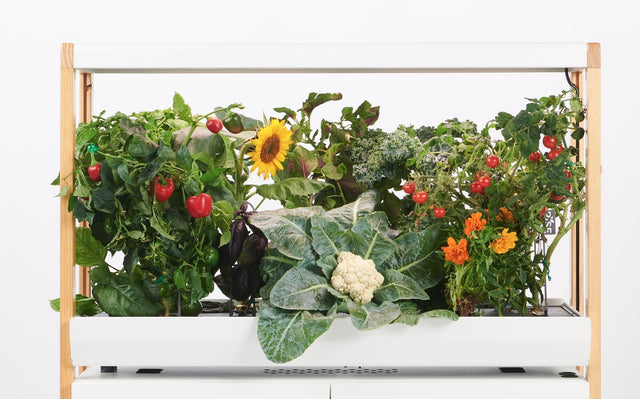
Companies will source seeds that fit their system, are usually determinate seeds, and don’t take up too much space in your garden. If you select an indeterminate seed, that means your plant could be 2-3-4 or more feet tall. In a horizontal garden, the plant will quickly outgrow the system. In a vertical system, you’ll need to have supports for a huge plant that’s up to 4 or 5 feet from your garden. We’ll go ahead and say it: that’s not going to work or be pretty.
Some companies offer seedlings so you can skip the germination process altogether. While that option certainly is appealing and easier, there are some downsides. Seedlings are grown in greenhouses, which means they are weather dependent and will follow the outdoor gardening season more closely. It will be harder to get tomato plant seedlings in January if you go this route vs. growing from seed, which eliminates the need to keep an eye on the Farmer’s Almanac. Just like plants from the store, you also run the risk of bringing pests like aphids and spider mites into your home since the seedlings are grown close together and it’s a natural breeding ground for pests.
Seed Pod Design
Seed pod design is also very important. Because the seed pod is your plant’s home while it’s growing, you should know the details of the plant pod. Quality and care vary widely among brands.
First, be sure you know what the growth material is made from. As we mentioned above, these seed pods are not made from soil–and you should not use soil in any indoor hydroponic system.
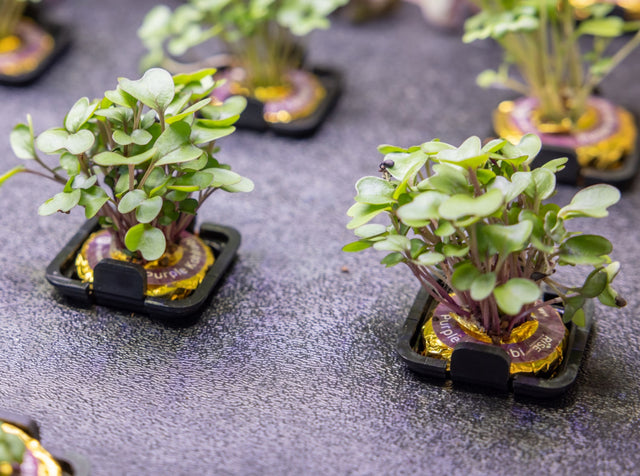
Your plant pod ingredients should be easy to find and 100% organic. This is a very low bar for indoor growing and something you shouldn’t compromise on. The top of the pod should be covered at some point in the germination process because hydroponic pods are very susceptible to algae growth. While algae is harmless to us and is a natural organism that may pop up in parts of your garden, it can hamper germination, and as it breaks down, it will attract fungus gnats that can damage young roots and be a nuisance in your home.
Be sure to read the reviews, too. Plant pods should be dried during the manufacturing process to ensure a sterile environment free from any type of bacteria or pests. Take a pass on the pods if they are damp. Your plants will thank you.
Nutrients
Outside of light source, the nutrients (aka plant food) you provide to your plants is one of the most important items to consider when you choose to start indoor gardening. Nutrients should be very easy to use and add to the garden, with clear and concise instructions on how much to add and when. Similar to outdoor gardening in soil, timing and sequence is key. In soil, your plant’s roots continue to grow deeper and deeper into the soil to access the nutrients they need. As you’ve surely experienced, the roots on a tomato plant are longer, bigger and stronger than the roots of a head of lettuce. That’s because they need other nutrients that are found in deeper levels of soil.
The same goes for hydroponic gardening, but it looks a little different. Professional-grade hydroponic nutrients are split into multiple groups with a starter nutrient blend that focuses on leaf and stem production and then a flowering and fruiting blend that is used once plants grow those organs (flowers and fruits like tomatoes and peppers).
Plants need a different ratio of nutrients in order to properly grow their reproductive organs. If an indoor garden has a one-part mixture, it’s cutting corners on biology and simplifying things too much. What does that mean? Simply put, they’re leaving out key nutrients for your plants to properly grow, which means you’ll see smaller plants and lower yields.
Outside of nutrient content, pH management is vital for the growth of your plant because without the proper level of pH, your plants won’t be able to absorb the nutrients and it can stunt the growth of your plants. The most basic hydroponic nutrients should have an additional pH management solution that gets added to your water to lower the pH. Every home’s tap water is different so being able to change the pH to fit your home is very important.
Garden Accessories
Make sure you have the support to grow your plants big and strong
Have you ever tried gardening outdoors and not using any accessories like trellises, cages, and other supports? We’re betting it was a mess. The same goes with indoor gardening. If you want the Instagram-worthy post a company shares on their feed, you’re going to need some accessories to help. Of course, they’re not just for looks. They help plants through their growth stages and provide support when they become loaded with their fruits.
Plant stand
If you want to grow larger plants like tomatoes and peppers, there should be some way of staking those plants or supporting them so they don’t fall over. Because hydroponic plants have a different root structure than soil plants, they tend to fall over without proper support. When looking at gardens, vertical and horizontal systems each have their own pros and cons. Adding some accessories to a vertical tower system can be challenging and result in large plants that fall over and break. Horizontal systems are designed similar to traditional soil gardening, which makes adding plant accessories easy.
Vining plants will need some type of trellis in order to stay organized and grow vertically. Again, in a horizontal system, you can easily place a trellis and guide your vining plants along its frame. Vertical tower systems don’t always provide the same space and end up with vining plants covering other plants or pooling and expanding on your floor. You’ll need to consider these tradeoffs with a tower system and provide additional space around your garden for your plants to grow into.
Arguably, the most important external piece to your garden is some type of nursery where a humidity dome ensures the temperature and humidity stay high for seed germination. The environment in which your seeds germinate also affects later stage growth and even yield. If you’ve had trouble with meeting your growing and yield expectations in the past, try germinating in a nursery.
Nursery
A nursery also improves your ability to crop plan and have seedlings started before you harvest an old plant so that you can maintain the growth of your garden and not experience large gaps between harvests.
Lights
Make sure you understand the importance of light
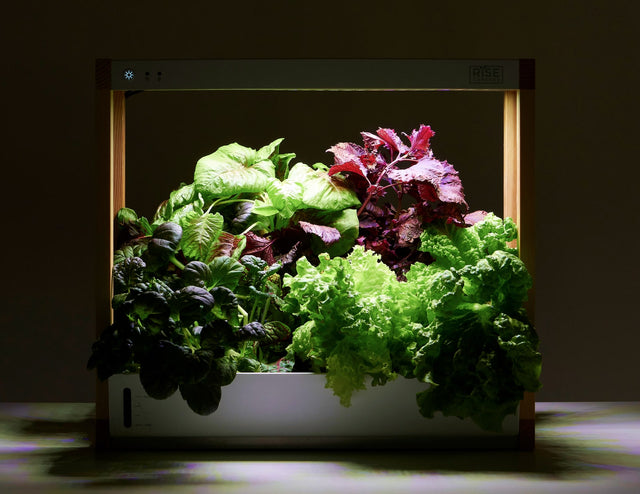
Light Spectrum
For any indoor garden, you will want to pay close attention to the lights since they are the main food source for your plants. Professional lights will be a mixture of full spectrum (white) and focused spectrum (red and blue). When plants perform photosynthesis (converting light into energy), they only use specific wavelengths that happen to be red and blue light. Current research has shown that other wavelengths can impact early growth, but white light helps to balance out the visible light so that you have a less intense spectrum for your home.
Light Intensity
The strength of the light is important because different plants need different amounts of light to grow correctly. No indoor light is going to compare to the power of the sun–and if it did, you’d probably not want it in your home.
The most common unit to measure light for plants is the PAR value, which stands for Photosynthetic Active Radiation. This value ranges from 100-200 for greens and herbs to 300-500 for fruiting and flowering plants. In general, you want a PAR of 350 (measured 6” from the light) to grow all types of plants. In order to maximize growth in your garden, you should be able to change the light hours of your garden so that you can increase in the winter months when natural light is low, and decrease in the summer when natural lighting is strong.
Even though you want to have powerful lights in your garden for your plants, you still have to live with this garden in your home. Look for lights that are not blinding you from your couch or dining room table. A dimming button or feature that is easy to access can help manage this issue as well.
Access to the Light
One last thing to consider when looking at a system’s light source is the space it covers. If the lighting source doesn’t cover a lot of space, growing plants that are larger than the light space will affect the plant’s growth and yield. Typically, this will be relevant to large fruiting plants and is why you’ll see some garden companies recommend not growing large fruiting plants in their systems while using an indoor lighting source. The plant will be looking for a light source and divert its energy to the portion of the plant that is outside the direct light source. Inadvertently, it will produce less flowers, which means less fruits.
Sustainability
Understand how you can further help save the planet
What to look for
The foundations of advancements in hydroponic technology stem from decreasing water usage and lowering the land footprint of agriculture. These improvements to current agricultural practices are focused on resource management and thus, as a home product, these concepts should also be present from a company level.
Plastics and Packaging
Plastics are now widely known to be harmful to our environment. There’s an urgent need to reduce the amount of plastic that we produce. As much as we try to reduce our own consumption of plastic, we need large corporations to adopt alternatives to single use plastics. The bare minimum a company can do to reduce its impact on the environment is to find sustainable alternatives to single use plastics in their packaging. Due to one of the underlying goals of urban agriculture and hydroponic technology being sustainability, it’s important to look for companies who are aware of their product’s carbon footprint.
Unfortunately, it will be almost impossible to avoid plastic in the structure of a hydroponic system as running water and the need to keep shipping and product costs low enough to be affordable for home use (alternatives can be very heavy), means plastic is the best choice. The best alternative is to consider a slightly more expensive garden that may use materials like wood, metal, ceramics, or even PLA (plant based plastic). It’ll also last longer, which means it will lead to less waste and not end up at the landfill and be replaced with more plastic.
You’ll also want to look at the company’s packaging for seeds, nutrients, and other products. Excessive packaging is a key indicator that they don’t take sustainability seriously. Also, look to see if their packaging is recyclable. Sometimes you can’t get around packaging, but a company that makes every effort to use as much recyclable material as possible is demonstrating a good faith effort towards sustainability. If a company cares about the effects their practices have on the earth, they care about their customers and the impact they have on the planet future generations will inherit.
Support
Make sure you’re getting all the support and growing guidance you need
Warranty
Your indoor garden should have an extended warranty to ensure that your garden, with all of the moving parts, electronics and plumbing, functions well into its usage. A high-quality garden should have a minimum of a 2 year warranty on all hardware to ensure heavy usage does not impede growing. They should also include at least a one year warranty on all electronics to ensure any factory defects are covered.
Clear Startup Process
The startup process should take less than an hour and should come with a well-designed user manual that gets you familiar with all parts and nouns of the garden. During a customer service interaction, you want to know the name of the part that you need help with.
Plant Health
Unlike growing in soil, spotting issues with plants in a hydroponic system can usually be solved quickly with a few adjustments to the nutrient levels or through basic plant management (spacing out plants, pruning, pollinating). However, which of these adjustments to use on which plant can be confusing without specific guidance. The best method for understanding the care of your plant is to have an easy to follow check list of care steps as the plant matures. Each genre of plant (herb, flower, leafy greens, fruit, etc.) has specific needs in order to perform its best, and having a comprehensive guide available will determine if this indoor garden can produce an abundance of produce.
Customer Support
When troubleshooting, the support team at the company you obtained your garden from should have experts on staff that have a background in horticulture and hydroponics in order to troubleshoot fringe cases and specific plant questions.
Community
Consider the advantages of having a community to join and grow together. Many companies create customer groups to help you connect with other gardeners on the same growing journey. They can answer questions, provide advice, and even inspire you to grow different plants and try new things.
Current users of the product will provide a great perspective on issues and success that are just not possible to obtain from someone who works for the company. Just like a community garden where you can walk over to another gardener’s plot, you should have access to a community to learn from.
Supplemental material is important too. Consider the information they share with their users in their help centers, blogs, and social media. Companies who spend time and resources generating this type of content value the journey their community is experiencing and strives to ensure the best experience possible. A little inspiration goes a long way, too.
